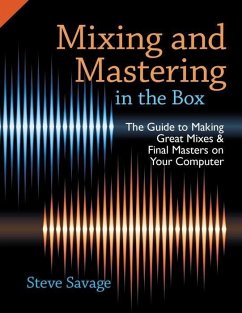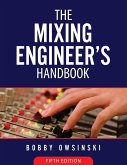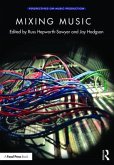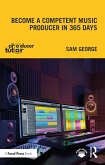Steve Savage (Instructor of Recording Instructor of Recording Arts
Mixing and Mastering in the Box
The Guide to Making Great Mixes and Final Masters on Your Computer
Steve Savage (Instructor of Recording Instructor of Recording Arts
Mixing and Mastering in the Box
The Guide to Making Great Mixes and Final Masters on Your Computer
- Broschiertes Buch
- Merkliste
- Auf die Merkliste
- Bewerten Bewerten
- Teilen
- Produkt teilen
- Produkterinnerung
- Produkterinnerung
This book is the ultimate reference manual for the home recordist and the perfect basic to intermediate text for any DAW (Digital Audio Workstation) training class in mixing or mastering. The book also provides ideal training for musicians who either do their own mixing and mastering or wish to be better informed when collaborating on mixes and masters.
Andere Kunden interessierten sich auch für
![The Mixing Engineer's Handbook 5th Edition The Mixing Engineer's Handbook 5th Edition]() Bobby OwsinskiThe Mixing Engineer's Handbook 5th Edition35,99 €
Bobby OwsinskiThe Mixing Engineer's Handbook 5th Edition35,99 €![Mixing Audio Mixing Audio]() Roey IzhakiMixing Audio56,99 €
Roey IzhakiMixing Audio56,99 €![Game Audio Mixing Game Audio Mixing]() Alex RiviereGame Audio Mixing36,92 €
Alex RiviereGame Audio Mixing36,92 €![Mixing Music Mixing Music]() Mixing Music93,99 €
Mixing Music93,99 €![Become a Competent Music Producer in 365 Days Become a Competent Music Producer in 365 Days]() Sam GeorgeBecome a Competent Music Producer in 365 Days35,99 €
Sam GeorgeBecome a Competent Music Producer in 365 Days35,99 €![Game Audio Mixing Game Audio Mixing]() Alex RiviereGame Audio Mixing180,99 €
Alex RiviereGame Audio Mixing180,99 €![Mixing in Flow Mixing in Flow]() Jane ArnisonMixing in Flow64,99 €
Jane ArnisonMixing in Flow64,99 €-
-
-
This book is the ultimate reference manual for the home recordist and the perfect basic to intermediate text for any DAW (Digital Audio Workstation) training class in mixing or mastering. The book also provides ideal training for musicians who either do their own mixing and mastering or wish to be better informed when collaborating on mixes and masters.
Produktdetails
- Produktdetails
- Verlag: Oxford University Press Inc
- Seitenzahl: 316
- Erscheinungstermin: 1. September 2014
- Englisch
- Abmessung: 280mm x 216mm x 18mm
- Gewicht: 800g
- ISBN-13: 9780199929320
- ISBN-10: 0199929327
- Artikelnr.: 40185563
- Herstellerkennzeichnung
- Libri GmbH
- Europaallee 1
- 36244 Bad Hersfeld
- gpsr@libri.de
- Verlag: Oxford University Press Inc
- Seitenzahl: 316
- Erscheinungstermin: 1. September 2014
- Englisch
- Abmessung: 280mm x 216mm x 18mm
- Gewicht: 800g
- ISBN-13: 9780199929320
- ISBN-10: 0199929327
- Artikelnr.: 40185563
- Herstellerkennzeichnung
- Libri GmbH
- Europaallee 1
- 36244 Bad Hersfeld
- gpsr@libri.de
An active producer, recording engineer, and music technology instructor, Steve Savage has been the primary engineer on seven Grammy-nominated CDs. He is the author of numerous books, including The Art of Digital Audio Recording: A Practical Guide for Home and Studio (OUP, 2011) and Bytes & Backbeats: Repurposing Audio in the Digital Age (Michigan, 2011).
Contents
Introduction
Part I - Mixing and Mastering
Introduction to Part I
1. The Starting Point
1.1 Preparing to mix and master
1.2 Where to mix and master
1.3 The tools of mixing and mastering
1.4 Introduction to the "Quick Guide "
2. Quick Guide to Great Mixes and Masters: Five best practices
2.1 Have a concept
2.2 Monitor level
2.3 Monitoring options
2.4 Revise, revise, revise
2.5 Live with your mix or master
3. Quick Guide to Great Mixes and Masters: Four common mistakes
3.1 Poor control of the low end
3.2 Overly bright mixes and masters
3.3 Overly compressed mixes and masters
3.4 Trusting inadequate monitoring
Part II - Mixing
Introduction to Part II
4. Building a Mix: The concepts and tools in detail
4.1 Starting concepts and setting level
4.2 Panning
4.3 Processing: EQ
4.4 Processing: Dynamics
4.5 Processing: Effects
4.6 Processing: What else is in the box?
4.7 The stereo buss
5. Automation and Recall: Fine-tuning
5.1 Online versus off-line automation
5.2 Details of online automation
5.3 Details of off-line automation
5.4 Timeline of automation
5.5 From simple to complex mixes
5.6 Fades
5.7 Advanced automation techniques
5.8 Recall
6. Mixing Piece by Piece: How to approach individual elements
6.1 Drums and percussion
6.2 Bass
6.3 Guitar
6.4 Keyboards
6.5 Vocals
6.6 Horns
6.7 Strings
7. Mix Collaboration: The mix team
7.1 How to communicate about mixes
7.2 Levels of mixer intervention
7.3 Managing remote mixing projects
8. Delivering Mixes: Formats, mix types and multiple mixes
8.1 Digital formats for mix delivery
8.2 Full mixes, TV mixes, and clips
8.3 Multiple versions of a single mix
PART III - Mastering
Introduction to part III
9. Setting Up to Master: Tools and files
9.1 Tools
9.2 Creating a template
9.3 Building the timeline
10. How to Listen for Mastering: From your ear to action
10.1 Level
10.2 Frequency/EQ
10.3 Dynamics and effects
10.4 Consistency
11. Creating a Master: The concepts and tools in detail
11.1 Creating a reference track
11.2 Processing: EQ
11.3 Processing: Level
11.4 Processing: Dynamics and effects
11.5 What else is in the box?
12. The Final Master: Creating and delivering
12.1 Creating a master
12.2 Formats and delivery options
13. Mastering Collaboration: The mastering team
13.1 How to talk about mastering
13.2 Levels of mastering intervention
13.3 Managing remote mastering projects
Addendum I: Notes on surround mixing and mastering
Addendum II: Why mixing and mastering can no longer be separated
Index
Introduction
Part I - Mixing and Mastering
Introduction to Part I
1. The Starting Point
1.1 Preparing to mix and master
1.2 Where to mix and master
1.3 The tools of mixing and mastering
1.4 Introduction to the "Quick Guide "
2. Quick Guide to Great Mixes and Masters: Five best practices
2.1 Have a concept
2.2 Monitor level
2.3 Monitoring options
2.4 Revise, revise, revise
2.5 Live with your mix or master
3. Quick Guide to Great Mixes and Masters: Four common mistakes
3.1 Poor control of the low end
3.2 Overly bright mixes and masters
3.3 Overly compressed mixes and masters
3.4 Trusting inadequate monitoring
Part II - Mixing
Introduction to Part II
4. Building a Mix: The concepts and tools in detail
4.1 Starting concepts and setting level
4.2 Panning
4.3 Processing: EQ
4.4 Processing: Dynamics
4.5 Processing: Effects
4.6 Processing: What else is in the box?
4.7 The stereo buss
5. Automation and Recall: Fine-tuning
5.1 Online versus off-line automation
5.2 Details of online automation
5.3 Details of off-line automation
5.4 Timeline of automation
5.5 From simple to complex mixes
5.6 Fades
5.7 Advanced automation techniques
5.8 Recall
6. Mixing Piece by Piece: How to approach individual elements
6.1 Drums and percussion
6.2 Bass
6.3 Guitar
6.4 Keyboards
6.5 Vocals
6.6 Horns
6.7 Strings
7. Mix Collaboration: The mix team
7.1 How to communicate about mixes
7.2 Levels of mixer intervention
7.3 Managing remote mixing projects
8. Delivering Mixes: Formats, mix types and multiple mixes
8.1 Digital formats for mix delivery
8.2 Full mixes, TV mixes, and clips
8.3 Multiple versions of a single mix
PART III - Mastering
Introduction to part III
9. Setting Up to Master: Tools and files
9.1 Tools
9.2 Creating a template
9.3 Building the timeline
10. How to Listen for Mastering: From your ear to action
10.1 Level
10.2 Frequency/EQ
10.3 Dynamics and effects
10.4 Consistency
11. Creating a Master: The concepts and tools in detail
11.1 Creating a reference track
11.2 Processing: EQ
11.3 Processing: Level
11.4 Processing: Dynamics and effects
11.5 What else is in the box?
12. The Final Master: Creating and delivering
12.1 Creating a master
12.2 Formats and delivery options
13. Mastering Collaboration: The mastering team
13.1 How to talk about mastering
13.2 Levels of mastering intervention
13.3 Managing remote mastering projects
Addendum I: Notes on surround mixing and mastering
Addendum II: Why mixing and mastering can no longer be separated
Index
Contents
Introduction
Part I - Mixing and Mastering
Introduction to Part I
1. The Starting Point
1.1 Preparing to mix and master
1.2 Where to mix and master
1.3 The tools of mixing and mastering
1.4 Introduction to the "Quick Guide "
2. Quick Guide to Great Mixes and Masters: Five best practices
2.1 Have a concept
2.2 Monitor level
2.3 Monitoring options
2.4 Revise, revise, revise
2.5 Live with your mix or master
3. Quick Guide to Great Mixes and Masters: Four common mistakes
3.1 Poor control of the low end
3.2 Overly bright mixes and masters
3.3 Overly compressed mixes and masters
3.4 Trusting inadequate monitoring
Part II - Mixing
Introduction to Part II
4. Building a Mix: The concepts and tools in detail
4.1 Starting concepts and setting level
4.2 Panning
4.3 Processing: EQ
4.4 Processing: Dynamics
4.5 Processing: Effects
4.6 Processing: What else is in the box?
4.7 The stereo buss
5. Automation and Recall: Fine-tuning
5.1 Online versus off-line automation
5.2 Details of online automation
5.3 Details of off-line automation
5.4 Timeline of automation
5.5 From simple to complex mixes
5.6 Fades
5.7 Advanced automation techniques
5.8 Recall
6. Mixing Piece by Piece: How to approach individual elements
6.1 Drums and percussion
6.2 Bass
6.3 Guitar
6.4 Keyboards
6.5 Vocals
6.6 Horns
6.7 Strings
7. Mix Collaboration: The mix team
7.1 How to communicate about mixes
7.2 Levels of mixer intervention
7.3 Managing remote mixing projects
8. Delivering Mixes: Formats, mix types and multiple mixes
8.1 Digital formats for mix delivery
8.2 Full mixes, TV mixes, and clips
8.3 Multiple versions of a single mix
PART III - Mastering
Introduction to part III
9. Setting Up to Master: Tools and files
9.1 Tools
9.2 Creating a template
9.3 Building the timeline
10. How to Listen for Mastering: From your ear to action
10.1 Level
10.2 Frequency/EQ
10.3 Dynamics and effects
10.4 Consistency
11. Creating a Master: The concepts and tools in detail
11.1 Creating a reference track
11.2 Processing: EQ
11.3 Processing: Level
11.4 Processing: Dynamics and effects
11.5 What else is in the box?
12. The Final Master: Creating and delivering
12.1 Creating a master
12.2 Formats and delivery options
13. Mastering Collaboration: The mastering team
13.1 How to talk about mastering
13.2 Levels of mastering intervention
13.3 Managing remote mastering projects
Addendum I: Notes on surround mixing and mastering
Addendum II: Why mixing and mastering can no longer be separated
Index
Introduction
Part I - Mixing and Mastering
Introduction to Part I
1. The Starting Point
1.1 Preparing to mix and master
1.2 Where to mix and master
1.3 The tools of mixing and mastering
1.4 Introduction to the "Quick Guide "
2. Quick Guide to Great Mixes and Masters: Five best practices
2.1 Have a concept
2.2 Monitor level
2.3 Monitoring options
2.4 Revise, revise, revise
2.5 Live with your mix or master
3. Quick Guide to Great Mixes and Masters: Four common mistakes
3.1 Poor control of the low end
3.2 Overly bright mixes and masters
3.3 Overly compressed mixes and masters
3.4 Trusting inadequate monitoring
Part II - Mixing
Introduction to Part II
4. Building a Mix: The concepts and tools in detail
4.1 Starting concepts and setting level
4.2 Panning
4.3 Processing: EQ
4.4 Processing: Dynamics
4.5 Processing: Effects
4.6 Processing: What else is in the box?
4.7 The stereo buss
5. Automation and Recall: Fine-tuning
5.1 Online versus off-line automation
5.2 Details of online automation
5.3 Details of off-line automation
5.4 Timeline of automation
5.5 From simple to complex mixes
5.6 Fades
5.7 Advanced automation techniques
5.8 Recall
6. Mixing Piece by Piece: How to approach individual elements
6.1 Drums and percussion
6.2 Bass
6.3 Guitar
6.4 Keyboards
6.5 Vocals
6.6 Horns
6.7 Strings
7. Mix Collaboration: The mix team
7.1 How to communicate about mixes
7.2 Levels of mixer intervention
7.3 Managing remote mixing projects
8. Delivering Mixes: Formats, mix types and multiple mixes
8.1 Digital formats for mix delivery
8.2 Full mixes, TV mixes, and clips
8.3 Multiple versions of a single mix
PART III - Mastering
Introduction to part III
9. Setting Up to Master: Tools and files
9.1 Tools
9.2 Creating a template
9.3 Building the timeline
10. How to Listen for Mastering: From your ear to action
10.1 Level
10.2 Frequency/EQ
10.3 Dynamics and effects
10.4 Consistency
11. Creating a Master: The concepts and tools in detail
11.1 Creating a reference track
11.2 Processing: EQ
11.3 Processing: Level
11.4 Processing: Dynamics and effects
11.5 What else is in the box?
12. The Final Master: Creating and delivering
12.1 Creating a master
12.2 Formats and delivery options
13. Mastering Collaboration: The mastering team
13.1 How to talk about mastering
13.2 Levels of mastering intervention
13.3 Managing remote mastering projects
Addendum I: Notes on surround mixing and mastering
Addendum II: Why mixing and mastering can no longer be separated
Index









